Flexible Seating Creates Vibrant Learning Spaces
 By Kathleen Palmieri
By Kathleen Palmieri
As an elementary 5th grade teacher I teach all subject areas, and each one requires its own learning configuration.
Peer to peer learning has proven to be one of the most effective strategies in intermediate classrooms, and collaboration plays a key engagement role in my social studies, science, math, and reading/writing programs.
Recently my district has reserved funds to support teachers as they work to make classrooms optimal learning environments. Federal grants are also providing some funding for this purpose this year.
Interested teachers must write grant proposals aligning classroom needs to learning standards, research based benefits, and the profile of an elementary student. Optimization includes areas like increased creativity, engagement, social interaction, and redefining of tasks.
Planning for my students’ learning experiences
As I was writing my grant proposal, I researched the benefits of flexible seating and found this:
“[f]lexible seating gives students the option to control their physical environments in which they work best. In other words, with choices, students gain greater flexibility and control of their surroundings giving them the autonomy and comfort to stay engaged and focused. This leads to increased student engagement which is linked to higher motivation and academic performance, as well as improved overall behavior.” Source
Currently in my classroom I have the traditional student desks and chairs that were adequate in years past. However, today’s students are 21st century learners who will benefit greatly from a 21st century classroom environment that emphasizes collaboration. We want to build on this lifelong skill throughout their K-12 education and beyond.
My goal is to create a classroom that offers student choice in seating and offers me the option to easily configure the furniture in ways that will benefit student learning, whether it be for a hands-on science lab, math learning zones, reading groups, writing stations, social studies debates, class discussions or group projects.
This overarching goal is supported by my research and my visits to classrooms that have updated with flexible seating or “21st Century Furniture,” It’s evident that the ability to frequently reconfigure the room has helped to engage students in collaborative reading groups, Socratic seminars, and other learning strategies. Students can quickly create collaborative space, quiet space, areas to record with technology, and “WIN” space for Whatever Is Needed.
There is no “one size fits all” in learning
Flexible seating and new ergonomic styles of furniture help to meet the needs of multiple learning preferences and also help us address physical needs. Having adjustable seating/desks is important for anyone who has a need for crutches, braces, or a wheelchair due to a temporary injury or a debilitating physical condition.
Students will have a voice in their choice of seating, whether it be a traditional chair or a standing desk that might maximize their creativity, engagement, focus, and learning. And there’s a bonus to moveable seating: students can have a movement break as they help reconfigure the furniture for the next subject area or activity.
Any time students feel they have voice and ownership we promote positive feelings and excitement about attending school, which is very empowering. Along with meeting students’ physical, social, and cognitive needs, flexible classrooms also “encourage positive behavior and prevent disruptive behavior” which “leads to increased student engagement.”
One study in Turkey states, “Students learning in an environment specifically designed to be educationally stimulating have the ability to perform higher than those students who do not learn in such an environment.” Another study in Quebec, Canada found positive effects on fifth and sixth graders’ wellbeing and mental health.
Adding a new dimension to student choice
Having the ability to easily move furniture in the learning environment provides the opportunity to optimally set up for the next subject or learning activity. Students benefit from having the ability to help in this reconfiguration, and this helps them engage and anticipate as they set up their learning areas.
Student choice is the optimal term to use when it comes to updating the learning environment. This is the quintessential ingredient to student-centered learning.
For lots of vibrant options visit 16 Awesome Flexible-Seating Classrooms That’ll Blow Your Teacher Mind by the Bored Teachers staff. For lots of teacher perspective, visit this Edutopia page.
Image credit: Smith Systems
Kathleen Palmieri is a National Board Certified Teacher and NBCT Professional Learning facilitator. She is a fifth grade educator in upstate New York who reviews and writes regularly for MiddleWeb. With a passion for literacy and learning in the classroom, she participates in various writing workshops, curriculum writing endeavors, and math presentations. As a lifelong learner, she is an avid reader and researcher of educational practices and techniques. Collaborating with colleagues and globally on X/Twitter and expanding her education adventures at www.kathleenpalmieri.com are her ongoing practices.
































